How Preventive & Predictive Maintenance Can Boost First-Time Fix Rates
Preventive and predictive maintenance can boost first-time fix rates (FTFR) by reducing the need for reactive repairs and emergency fixes.
Here’s how you choose the right CAFM
How to write and present a world-beating business case for FM software
Download NowYou’ve got this far - you’ve identified your need for a CAFM and you may have internal permission to proceed with an RFP (Request for Proposal). You may even have been invited to submit a proposal for the funds to the board.
But it’s not enough to present the C-Suite or your finance team with a figure and just expect your choice to be rubber-stamped. In fact, going in under prepared to meet your board of directors could derail all the efforts you’ve gone to so far to get the tools you need.
If you want to win the argument for funding, you’ve got to build a business case. You’ve got to demonstrate that your purchase is required - that it will not just be a cost centre, but will actively cut costs and improve performance and enhance profitability.
FMs are great at what they do - but we know your core competency is not procuring digital solutions, particularly when it impacts other business areas.
This ebook is designed to help you understand and make the best business case for a CAFM- so that everybody in an organisation can see how it answers their needs.
A note for readers:
Throughout this guide, we’ve added sample copy and checklists for you to include in your final business case. These are suggestions for you to adopt and adapt as you build the killer proposal that will win your budget.
+
Who do you need to persuade to get the budget for your CAFM software investment - and what do they need to hear?
The finance team want to improve the accuracy of budgeting and the transparency of spending. They will want to know exactly how your proposed CAFM will help you control and report on budget vs spend. They will want to see evidence of how it can drive greater value for money from suppliers. They will also want to know if the system will integrate with their accounting system to improve efficiency and reduce accounting errors.
The BODs have financial and strategic objectives at heart. They want to know that teams are operating in the most frictionless and efficient way possible to deliver the best results for the business. But they are also led by the bottom line. Having a strong vision of the profitability of the business and the return on their investment will be key to their procurement decisions. Strategically they need to position their company for growth and protect the company from compliance risk and competitive threat.
IT are key gatekeepers for CAFM procurement. The IT team may not be responsible for directly implementing the CAFM solution you procure but they are responsible for cybersecurity and data protection in your organisation. The rest of the business will depend on them for their professional opinion of the solution on offer. They will want to know whether your supplier has a strong ISMS (information security management strategy), what integrations are supported and that their support SLAs are sound. But they will also want reassurances that implementation and support of the product is not going to drain their budget and be their headache.
These teams at the top of the business control your access to budget - they have separate goals but some clear common interests.
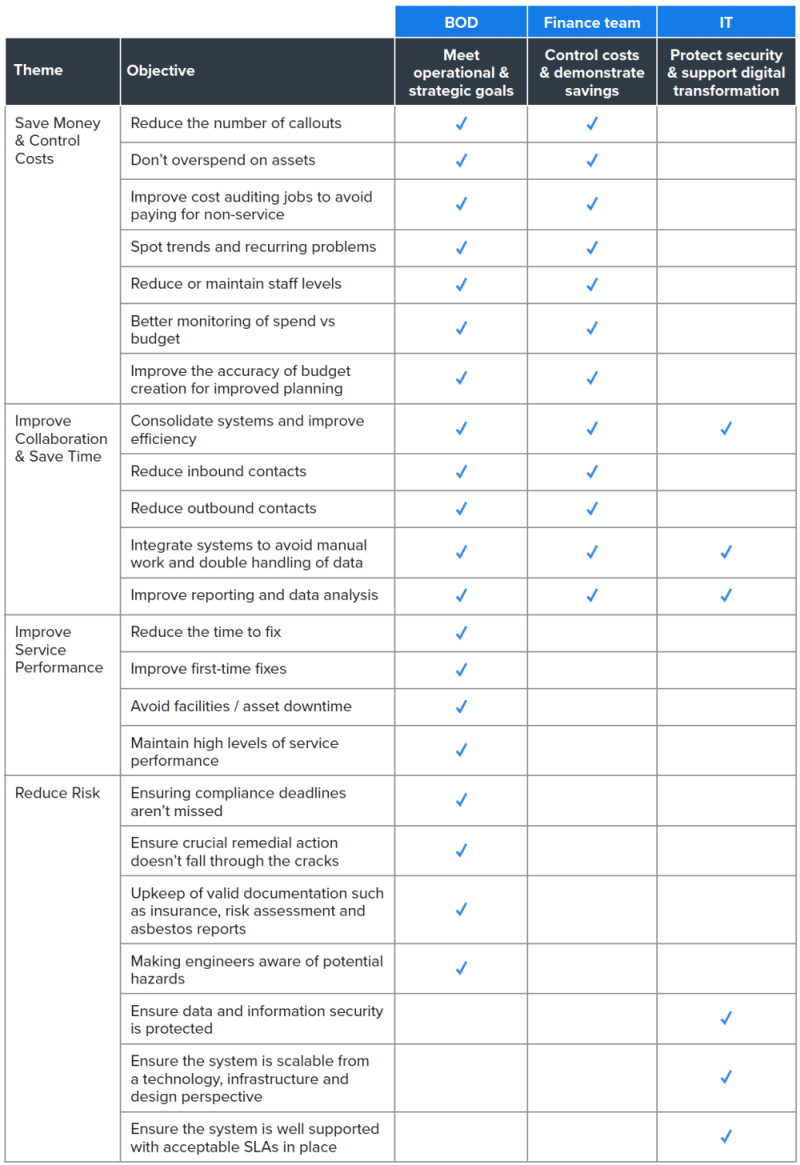
Want a copy to take away?
Learn how to write and present a world-beating business case for FM software
.png)
CAFM solutions can be expensive and many businesses have attempted to implement them before, and failed. The research shows over and again that CAFM implementations fail because:
Some among the BODs may well have experienced failed CAFM projects before and be hostile to the prospect of increased workload and disruption that a major implementation project might bring.
The IT team particularly may be suspicious of an increase to their workload and responsibility for any breach of data security resulting in a purchase.
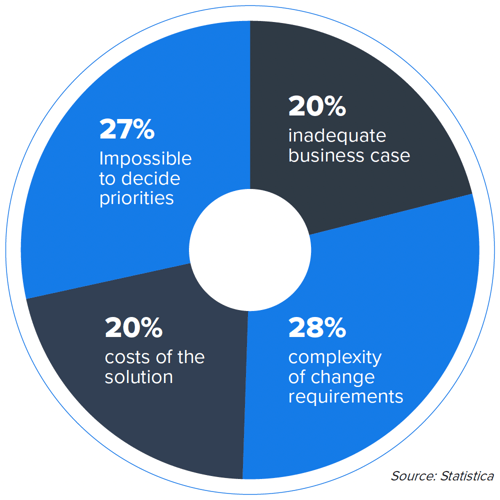
If you’re going to persuade the BODs, you’re going to need to speak directly to these concerns. You need to put a figure on the potential cost savings and inspire them with your vision of a streamlined FM function. On a practical level you need to persuade them that your CAFM implementation can be done with minimal disruption and within a realistic time frame.
Harvard Business Review
Write for your specific audience and the priorities we’ve listed above. But don’t just provide a ‘laundry list’ of features that the business needs to acquire. Make it very clear what’s at stake for each team, how your proposed solution can answer identified business challenges, and the benefits it will bring to the business as a whole.
Be clear in your writing - spell out exactly what the business will be getting for its money. Don’t hide your message behind too much FM jargon. Speak to the needs of the business as a whole. And don’t be afraid to edit. Keep it to the point. As the great writer Truman Capote puts it. “I believe more in the scissors than I do in the pencil.”
Make sure there’s a clear structure to your proposal. Turn it into a compelling narrative with a beginning, a middle and an end. Explain the problem, the potential solution, the risks to the business of not acting, and share your vision of a more efficient and profitable future with the more effective digital FM tools.
Illustrate your points with reference to the real world stats and trends that are making it essential for your business to act. A great source of FM stats and information can be found in the following online resources. But your CAFM partner should help you will supporting materials, too:
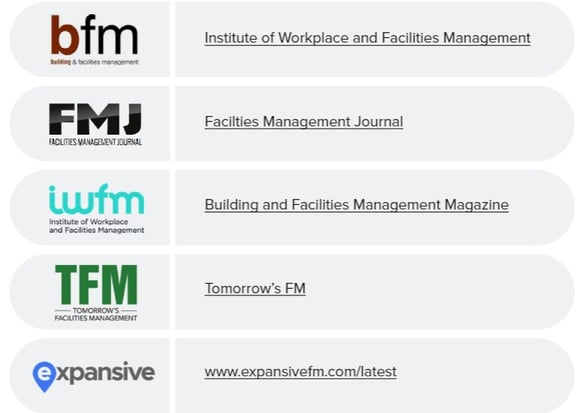
Charts, tables and screenshots are going to make your document more interesting and compelling. And a screen shot or two of your proposed CAFM solution (ideally populated with your data) will definitely help the BoD envisage what the proposed system will do for them.
This is the most important element of all, you need the figures to calculate the potential savings resulting from your solution. Your CAFM supplier should be able to help you access this information and present the best case to the board.
A powerful business case tells a story that speaks to the emotions of your audience as well as their business instincts. The BODs want to know that your solution will help them in the pursuit of excellence and build their reputation across the industry. But it needs to be a formal document backed up with real evidence to answer identifiable commercial objectives. Make sure you’re presenting your arguments in a document that covers the following points:
1. Executive summary
2. Business requirements
3. Proposed partner and solution
4. Benefits
5. Risks
6. Savings analysis
7. Timings
8. Summary
An executive summary (as the name suggests) summarises the key points of the document and is a compelling introduction as to what’s to come. Just follow your NOSE...
A reader should be able to look at your exec summary and understand at a high level what your business needs are and what your proposal entails - without reading the whole thing.
Using the classic ‘NOSE’ checklist ensures you’re making all the critical points of your business case on your opening page.
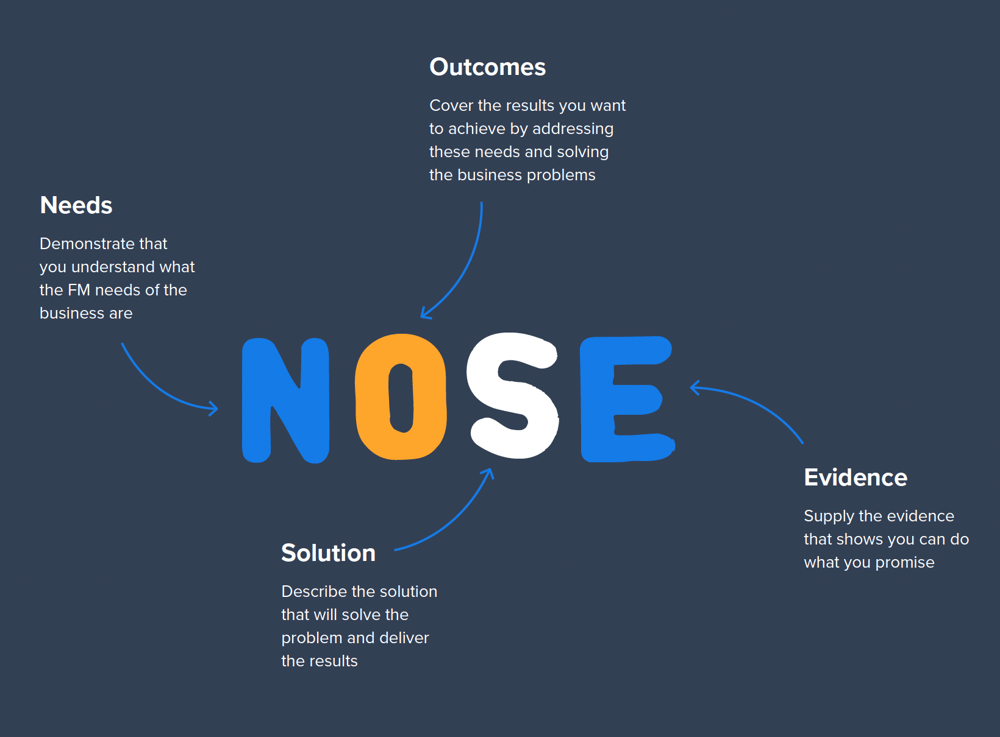
This section of the business case should describe the business problems that the proposed project will address. It should not describe how the problem will be addressed, only what the situation is.
Need some help? We've created some sample copy that you can adopt and adapt for your proposal:
Currently, our control and oversight of FM services is limited and our access to FM data is restricted. Our view of FM success is fragmented across various platforms making it difficult to benchmark and optimise our operations. This is threatening our ability to maintain service levels, control compliance risk and prepare for future competitive challenges. It is resulting in serious commercial inefficiencies, lost revenue and impacting our ability to plan strategically.
Expectations around the speed and efficiency of the FM team are growing. But we’re lacking the tools to automate our maintenance processes and streamline operations. Our call centre and engineers are still using clunky legacy tools. We’re still using spreadsheets, phone and email to organise maintenance. It’s slowing us down and increasing workload, as well as increasing the risk of mistakes.
• Response times are slow.
• First-time fix rates are low.
• Engineers are attending jobs under-prepared.
• Record keeping is patchy - vital compliance data is not being captured.
We currently have no way of centrally tracking and controlling spend against budget. We are losing money through:
• Duplicating work orders that generates unnecessary call outs.
• Lack of data analysis which which restricts our ability to audit costs effectively and efficiently.
• Lack of service performance management tracking and reporting which means we could be paying for missed SLAs.
• Our inability to consolidate work orders for a single visit to reduce callout charges.
• We are mainly reactive in our maintenance approach - we are losing opportunities to extend asset lifecycle through preventive maintenance and better lifecycle management.
• Asset lifecycle - we have no centralised storage capacity for asset documentation and recording service history, we can’t effectively monitor dilapidation, match warranties to equipment, or accurately predict Capex requirements.
• We’re unable to provide the data analysis that the team requires in order to make quick judgement calls on whether to repair or replace assets.
• Compliance is an increasing risk to our organisation. Our manual approach is preventing us from automating servicing and discharging mandatory H&S duties efficiently.
• We are struggling to ensure compliance documentation is up to date and have no automated capacity to alert the business when servicing is overdue or when we are in danger of H&S breaches.
• Remedial action is always at risk of slipping through the net as we do not have any central reporting capacity to capture
these requirements.
• Our company needs to collect and analyse more FM data to drive our insight and strategic decision making.
• Our directors need oversight and visibility of FM data to share and direct strategy to make us more profitable and efficient.
• A lack of integration with finance and other system systems risks creating more silos, confusion, duplication of work and other inefficiencies.
Provide a concise introduction to the partner and their software.
BACKGROUND
SERVICE
USP
EXPERIENCE
SECURITY
A deep dive into the benefits that the solution will bring the business. Both the hard and soft benefits of the CAFM solution are relevant here. But as always, lead with the need and speak to your BOD audience’s priorities.
Need some help? We've created some sample copy that you can adopt and adapt for your proposal:
Through implementing a CAFM we can save time and money, while reducing risk and improving performance.
A CAFM will help us automate, organise and report on all our FM activity in a single platform. It will be a single source of truth around our FM operations to support data-driven, strategic decision making.
Those functions include:
Let’s go into detail on the problems, solutions and benefits across these functions.
FM is fast becoming a 24/7/365 operation. We need to be there to meet new business needs wherever and whenever they arise.
With automated workflow management and other tools we aim to bring new efficiencies to our help desk process and improve service levels for our customers.
Workflow tools - what we need and why we need it
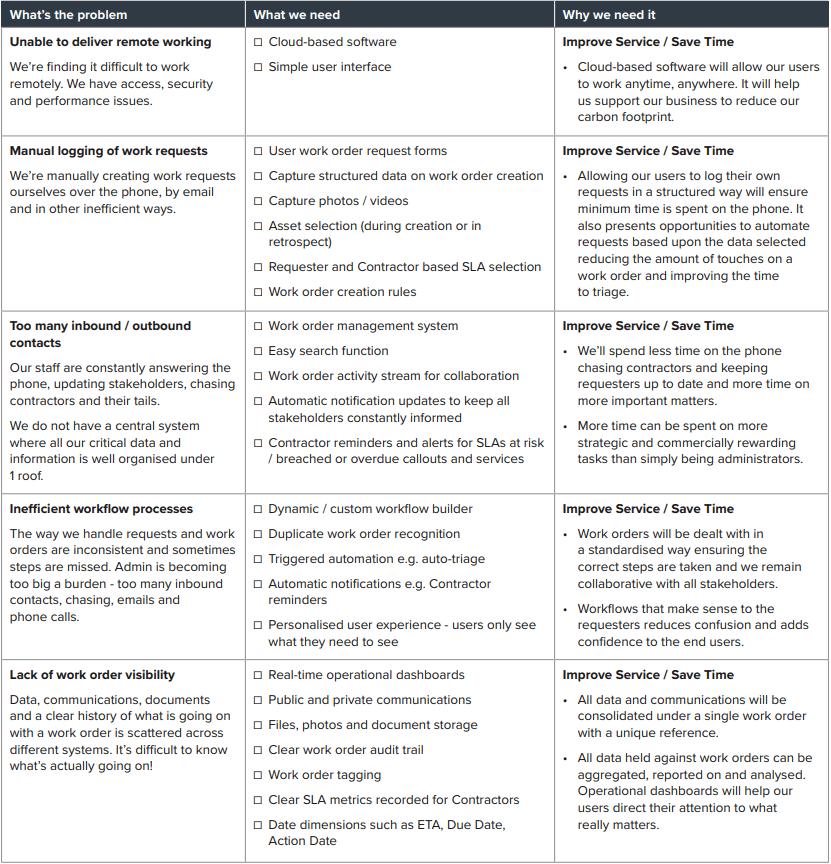
We’re outsourcing and dependent on contractors and other third parties more than ever before. We need the tools to report on, benchmark and optimise their performance.
Supply chain / resource management tools - what we need and why we need it
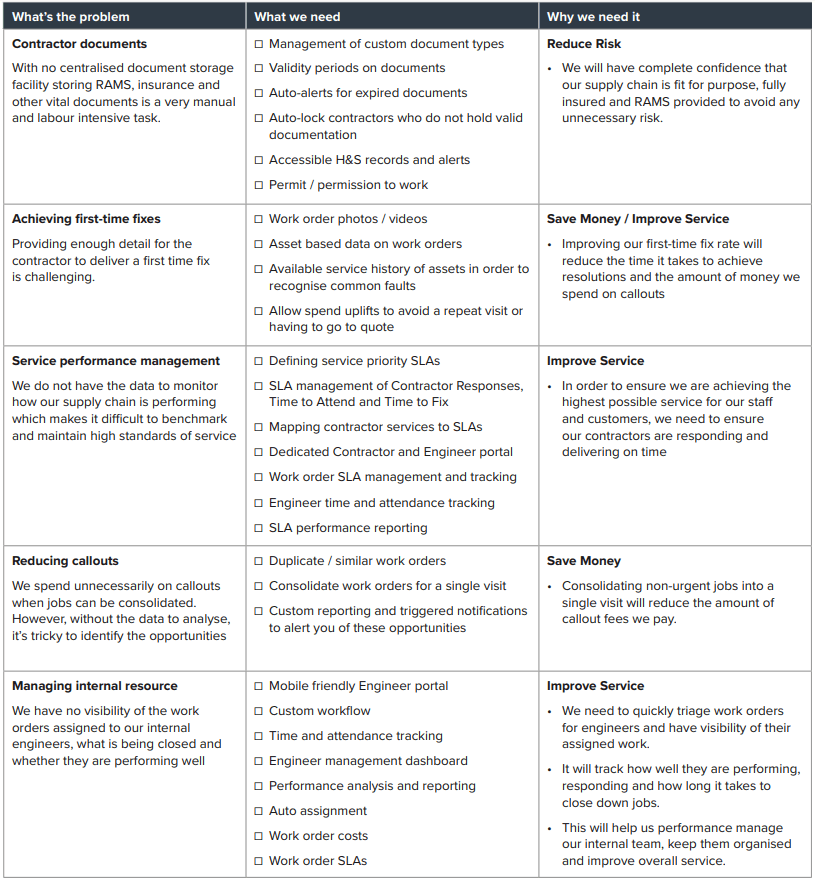
We are wasting money through our lack of reporting and access to performance critical data.
Cost control tools - what we need and why we need it
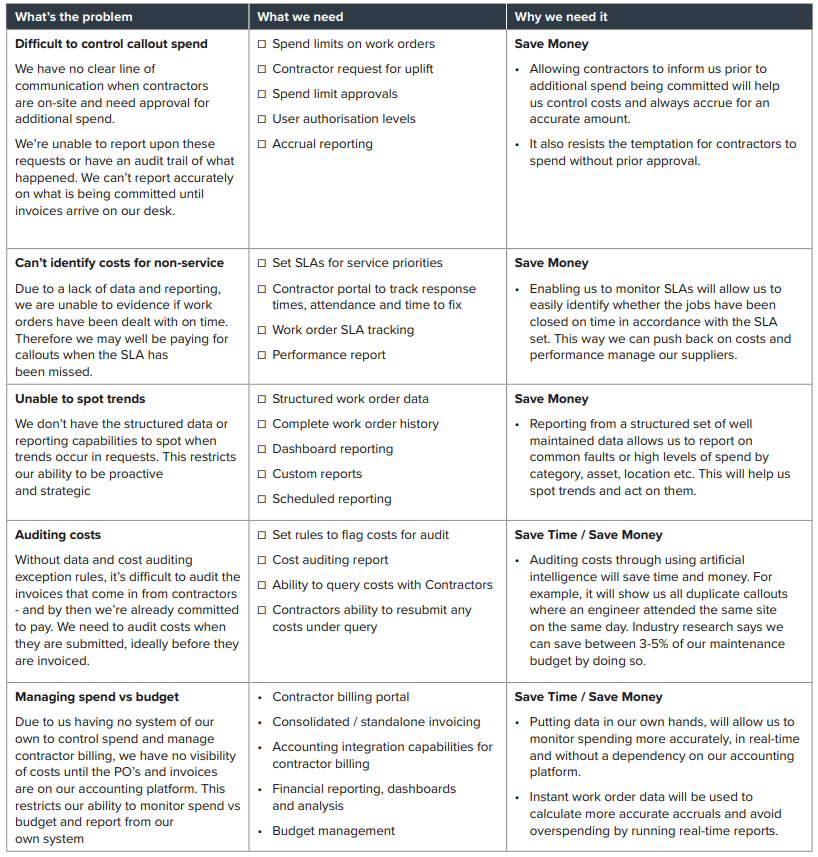
“Businesses, on average, spend 80% of their time reacting to maintenance issues that arise rather than preventing them.” Capterra
By setting up a digital asset register and a full asset management programme we expect to lengthen the lifespan of our assets, improve compliance management, plan Capex requirements and save the business money.
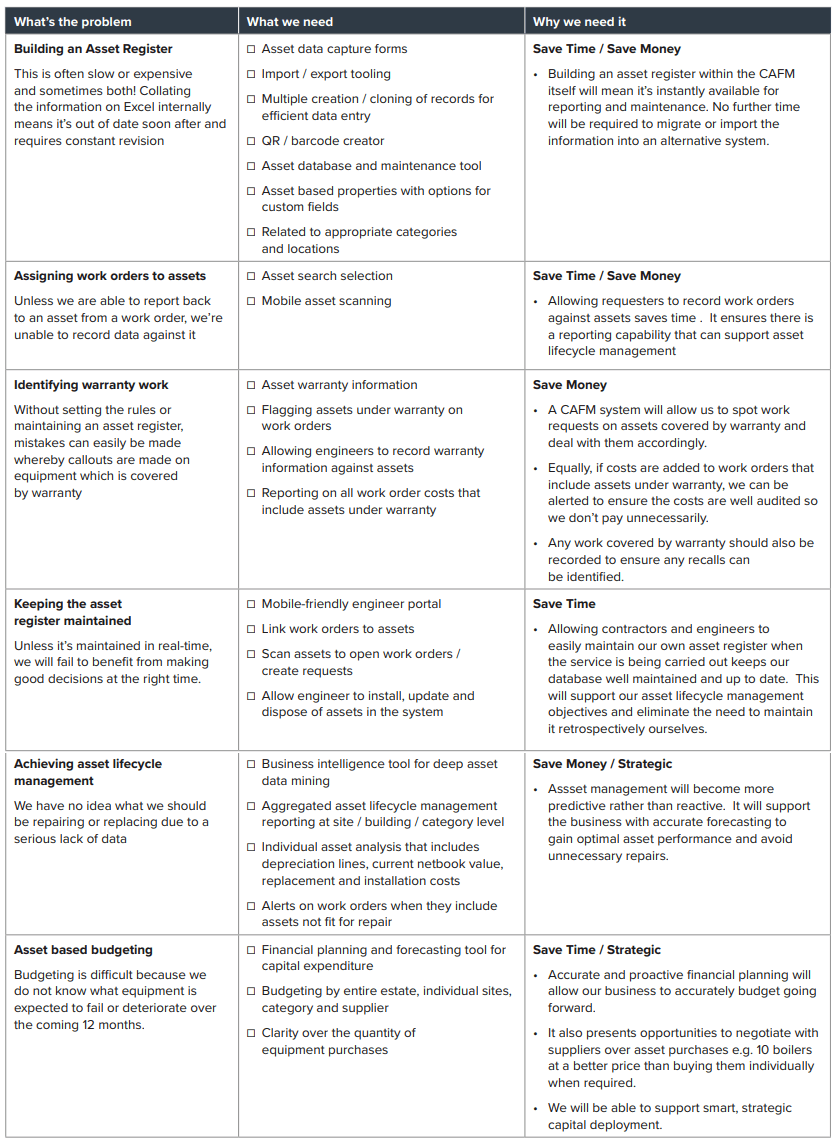
75% of businesses say: compliance is the biggest day to day concern and challenge of their FM team. (source Facilitate Magazine).
We need more oversight and control within our systems to reduce mounting risks stemming from increased regulation, as well as more complex equipment and maintenance regimes.
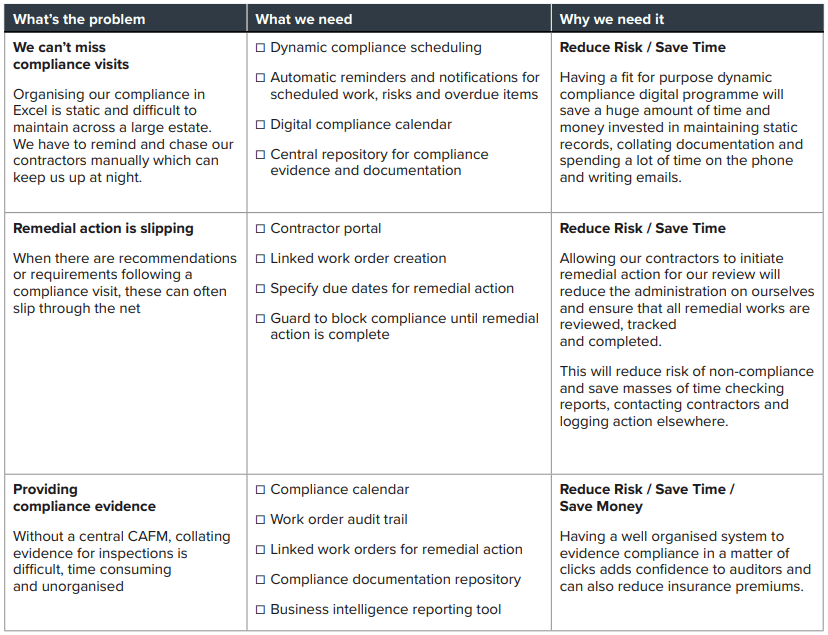
The business needs a holistic view of FM spend, performance and trends. The BOD wants to be able to see exactly where money is being spent, how their suppliers are performing and how data is driving the strategic direction of the operation.
The proposed CAFM purchase will be a business intelligence tool allowing us to instantly create, view and share visual reports in real-time.
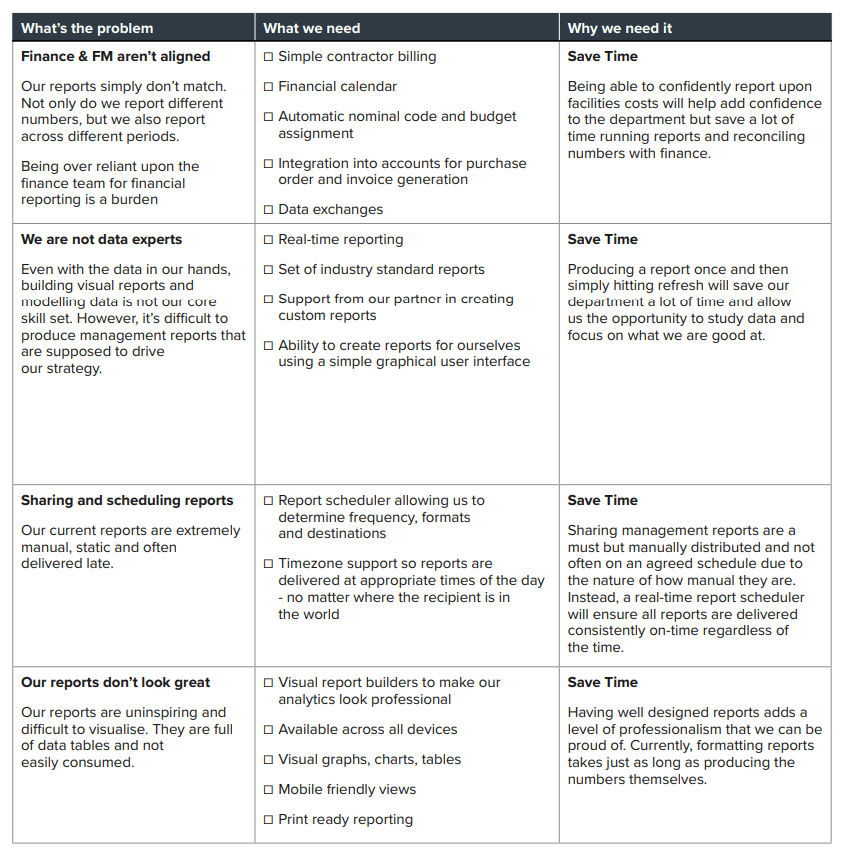
With a CAFM that makes this data available we can analyse trends more effectively, uncover new opportunities to drive cost control, efficiencies and revenue.
“The internet of things, combined with AI and machine learning, is set to make FM more responsive, predictive and cost effective” IWFM
In the future we will need our approach to FM to be more flexible and integrated. This will help us keep pace with changes in technology and new opportunities for cost saving and innovation.
Our proposed CAFM solution can use existing APIs to integrate rapidly with our current business systems.
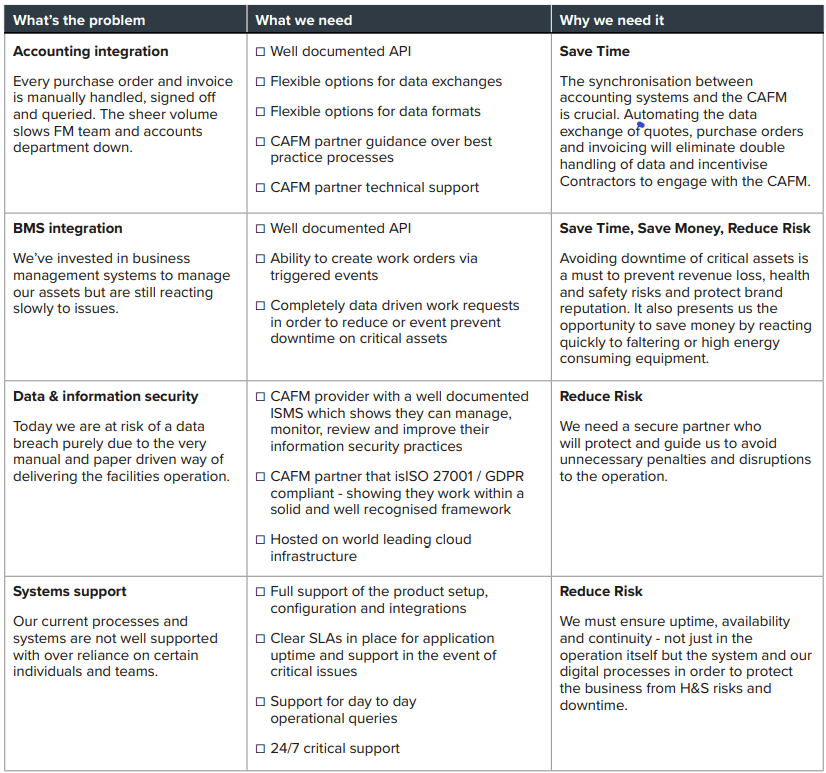
The comprehensive data migration and customer service package offered by the supplier will take day to day responsibility for internal support around help desk and asset management away from our internal IT team.
This is an opportunity to refocus our existing IT resources and budget away from internal, routine customer service activity and into long term, higher value strategic projects.
Remind your readers about the ongoing risk that a fragmented FM function poses in a changing world.
Need some help? We've created some sample copy that you can adopt and adapt for your proposal:
The expectations around FM performance in modern businesses have never been higher. Covid has shown how vital facilities management is in ensuring workers and customers’ safety, while driving revenue in disrupted times.
In the years to come, we are expecting yet more dramatic changes in business needs driven by technology. But we are lacking the digital tools to rise to these challenges.
If the business does not act now to correct these issues, we risk:
The procurement of a CAFM system is not always driven by cost cutting but also by the need to improve performance, reduce risk and other ‘soft benefits’.
However, it’s always recommended to highlight the savings that an FM digital transformation can bring to the business. The size of the saving can vary based on certain factors and scenarios, however this should give you some idea of what to expect.
Need some help? The below is an indication of the types of savings which should be possible. Use your own business data, budgets and resources to calculate what your FM digital transformation could be worth to you:
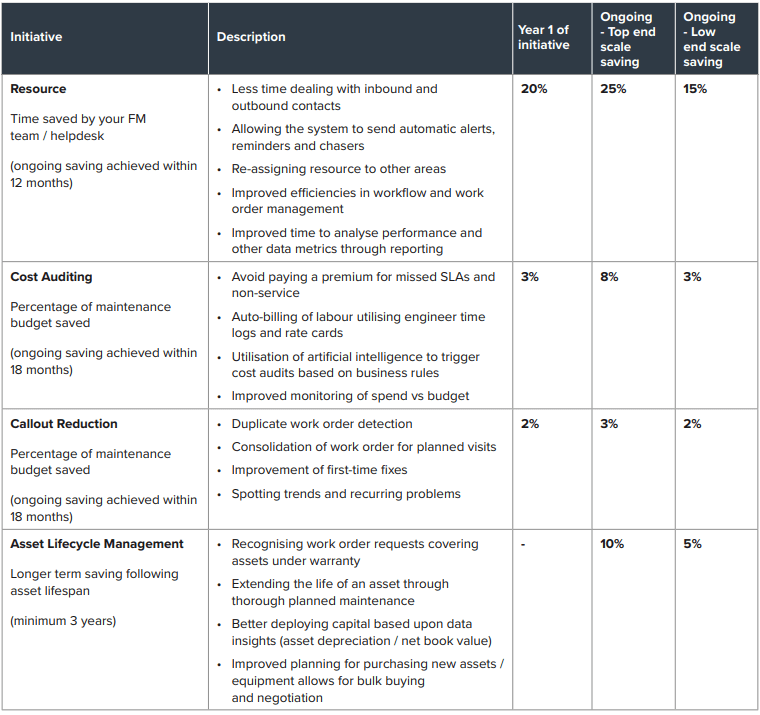
How long will the solution take to define, design and configure for your business?
The BODs need to know there is a plan for configuration and training within your team as they adopt the new solution. Should you suggest a staggered implementation of functionality to ensure the company sees business benefits and savings from the solution as quickly as possible? Your CAFM partner should help you workout a realistic timeline for implementation to present to the board.
This project plan outlines the key steps and milestones involved in the mobilisation of a CAFM system. The overall timescale and go-live strategy can vary depending upon project scope.
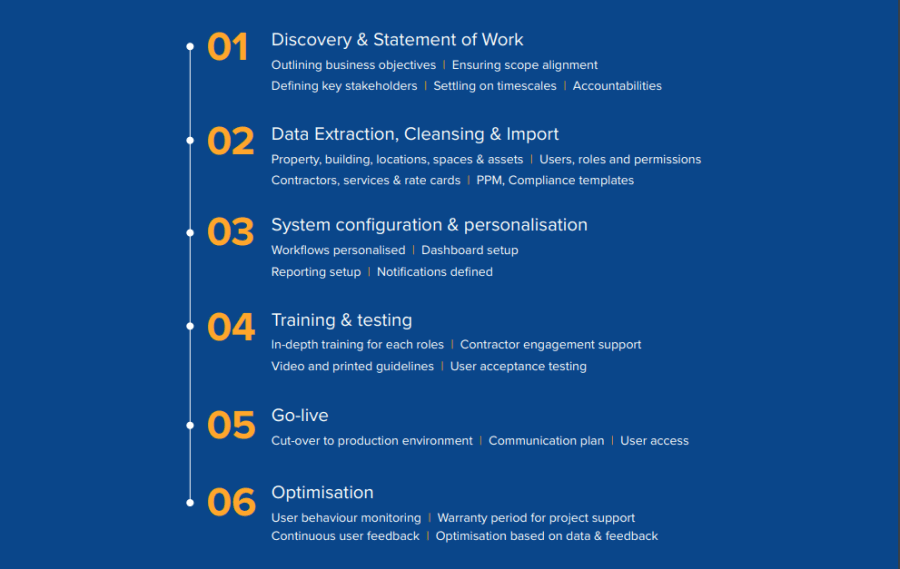
What do you need the reader to take away from this document?
Need some help? We've created some sample copy that you can adopt and adapt for your proposal:
We will have a powerful mobile first platform, with robust SLAs to support our digital growth and protect our data and cyber-security. It will liberate our IT resource to concentrate on big picture, strategic objectives.
Our FM team will have the tools they need to digitally organise and automate all our processes. We will be able to centralise reporting, manage spend and budget oversight through one single platform. We will save money and create more efficient ways of working.
The finance team will have confidence that our budgets will be an accurate reflection of our spending each year; that we can manage our equipment lifecycle and project required Capex.
In this proposal we have laid out the objectives, costs, timelines of a proposed CAFM implementation together with details of the savings we expect from it.
This CAFM will control business risk, but open up new opportunities for innovation and revenue growth.
Prepare yourself for the battle for budget
Open up discussions early on with your finance and IT teams to understand exactly what they need from a CAFM solution and bring them on side.
Let the team see the suppliers reporting suite, SLA and API documentation to answer their questions and address possible objections. They could become valuable advocates on your behalf.
This is your opportunity to back up your work with some key take-home messages.
Don’t forget to touch on all the points that affect your target audience - reminding them of the overall business benefits and the arguments you know count most with them.
Sales people perfect their ‘elevator pitch’ for just this reason. It’s the pitch for a project that can be delivered in a minute - the time it takes for an elevator to reach the top of a building. Rehearse for that precise moment when you have a ‘captive audience’ with the opportunity to listen.
How much time are FM teams currently losing through their manual process currently? How have you worked out your savings potential? Own the document and own the arguments within it.
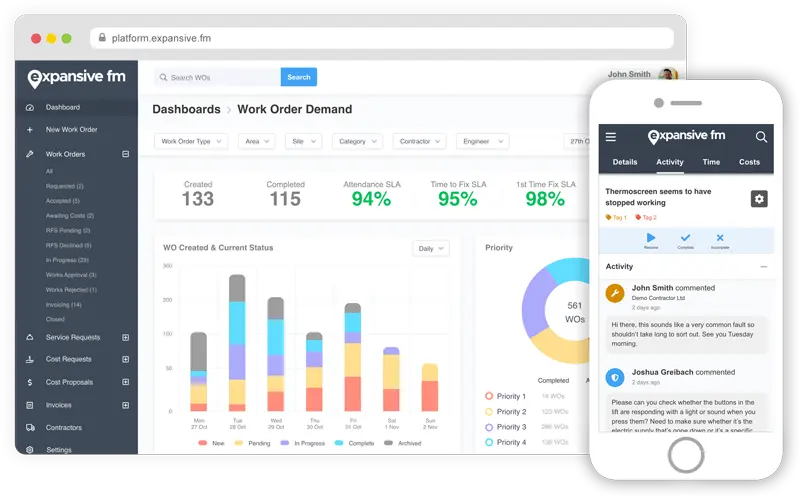
Preventive and predictive maintenance can boost first-time fix rates (FTFR) by reducing the need for reactive repairs and emergency fixes.
The manual quoting process is draining your sales team's energy and your bottom line. Every hour spent on spreadsheets is an hour not spent closing deals. Every pricing error is a potential client ...
Facilities Managers are often under pressure to reduce FM costs in their organisations. This can be achieved by focusing on a few key areas, such as implementing predictive maintenance, using smart ...
What's new at Expansive this month? This month, we've focussed on the ability to group contractors using tags as well as our new AI invoice submission tool.
What Is Facility Management? Facility Management, or FM, is the responsibility of keeping buildings and workplaces running smoothly. Whether it's an office, hospital, school, or manufacturing plant, ...
Whether you're running a single office or multiple sites across the country, the complexity of facility management demands smart solutions.